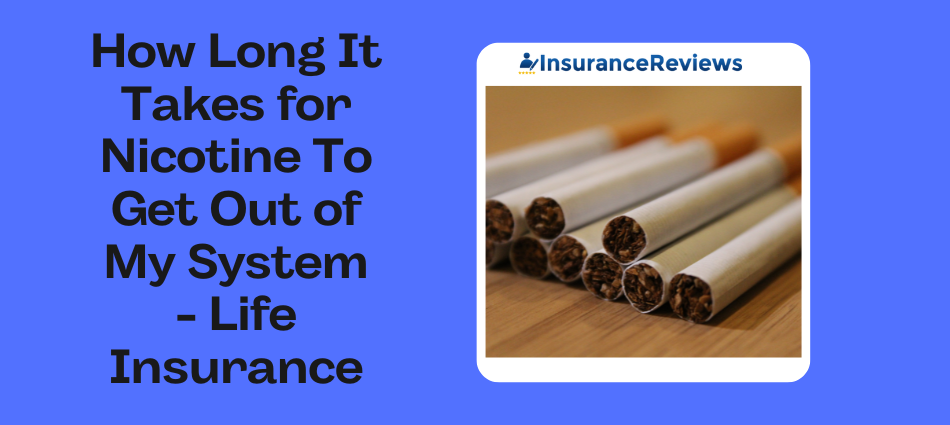If you’re a smoker or use tobacco in any form, it’s likely that nicotine will show up in your system. This can be a concern if you’re applying for life insurance as many insurance companies require a medical exam that includes testing for nicotine. But how long does it take to get nicotine out of your system for insurance? And what can you do to pass a nicotine test for health insurance? And what can you do to pass a nicotine test for health insurance?
In this article, we’ll explore the answers to these questions and more so you can be prepared for your insurance application and medical exam.
More Useful Guides on Life Insurance:
- Is Life Insurance a Good Career Path
- How Does Life Insurance Create an Immediate Estate
- How to Start Selling Life Insurance Successfully in 2023
- How To Use Life Insurance While Alive
To Answer the question: How long does it take for nicotine to get out of the system?
Nicotine can stay in your system for up to several days after you’ve used tobacco and its byproduct cotinine can stay in your system for even longer. Factors like the frequency and amount of tobacco use, as well as your individual metabolism, can impact how long it takes for nicotine to leave your system. Generally, it takes about a week for nicotine to fully clear from your system but it can take longer in some cases.
Watch the video below (2 mins) to know how to pass the life insurance nicotine test.
How long does nicotine stay in the system?
Nicotine can stay in your system for up to 3 days after you’ve used tobacco. Cotinine, a byproduct of nicotine, can stay in your system for longer, up to several weeks in some cases.
How long does it take to get nicotine out of the system for insurance?
Unfortunately, there’s no quick or guaranteed way to get nicotine out of your system. Your body will naturally metabolize and eliminate nicotine and cotinine over time. However, there are a few things you can do to help speed up the process like drinking plenty of water to help flush toxins out of your system.
However, it’s important to note that different life insurance companies may have different waiting periods for applicants who use tobacco. Some life insurance companies may require a longer period of abstinence, up to several months, before considering an applicant for a non-smoker rate. It’s important to check the specific requirements of these life insurance companies beforehand.
How to pass a nicotine test for health insurance.
If you use tobacco and need to pass a nicotine test for health insurance, it’s important to take steps to eliminate nicotine and cotinine from your system. While there’s no guaranteed way to pass a nicotine test for life insurance, there are some things you can do to increase your chances of passing. Here are five methods that may help:
Drinking Water With Lemon
Drinking plenty of water can help flush nicotine and cotinine out of your system. This is because water helps to dilute urine, which can reduce the concentration of nicotine and cotinine in your sample. Additionally, staying hydrated can help your body’s natural detoxification processes work more efficiently.
Drinking water with lemon can also help in passing a nicotine test for life insurance as lemon contains citric acid which can help flush out toxins from the body. The high water content in lemon juice can also help increase urine output and promote detoxification.
Exercise Regularly
Regular exercise can help increase your metabolism and promote sweating which can help to eliminate nicotine and cotinine from your body. It can also help to reduce stress and anxiety to make it easier to quit smoking or using tobacco products.
Eat A Healthy Diet
Nutritious foods like fruits, vegetables, lean protein, and whole grains can help support the body’s natural detoxification process and remove nicotine from the system.
Foods high in antioxidants like blueberries, spinach, and kale can help reduce oxidative stress caused by nicotine and its metabolites. On the other hand, processed foods, sugary drinks, and foods high in salt or fat can slow down the body’s metabolism and hinder the elimination of nicotine for life insurance.
Quit Smoking or Using Tobacco
The most effective way to pass a nicotine test for life insurance is to quit smoking or using tobacco products altogether. It takes time for the nicotine to leave the body but quitting smoking can help speed up the detox process.
Use a Nicotine Replacement Therapy
NRT is a medically-approved method to help quit smoking and pass a nicotine test for life insurance. NRT products like nicotine gum, patches, lozenges, inhalers, and nasal sprays work by delivering controlled amounts of nicotine to the body to alleviate withdrawal symptoms while avoiding the harmful chemicals in tobacco smoke.

Why do Insurance companies test for nicotine?
Life insurance companies test for nicotine because tobacco users are more likely to experience health issues and file claims related to their tobacco use. This puts a financial burden on life insurance companies and results in higher premiums for all policyholders.
In the past, individuals have committed fraud by lying on their life insurance applications about their tobacco use to receive lower premiums. Insurance companies now require nicotine testing to prevent fraud and ensure that policyholders are accurately assessed for risk.
Additionally, insurance companies may also use nicotine testing to comply with state laws and regulations and to protect their financial interests by accurately assessing risk. Therefore, it’s essential to be truthful about tobacco use when applying for life insurance policies to avoid potential legal and financial consequences.
Types of Life Insurance Nicotine Tests.
When you apply for life insurance, the insurance company may require you to take a nicotine test to determine your eligibility and premiums. There are several types of nicotine tests that insurers may use:
- Blood test. The blood test is a widely used type of nicotine test that life insurance companies often use. It measures the levels of cotinine, a metabolite of nicotine, in your bloodstream.
- Urine test. A urine test is another common nicotine test for life insurance that measures cotinine levels in your urine. This test is often used because cotinine can be detected in urine for a longer period of time than in blood.
- Saliva test. A saliva test is a less common nicotine test for life insurance that measures cotinine levels in your saliva. This test is commonly performed as it is non-invasive and yields rapid results.
- Hair follicle test. A hair follicle test is another less common nicotine test for life insurance that measures cotinine levels in your hair follicles. This test can detect nicotine use for a longer period of time than other tests.
- Sweat test. A sweat test is the least common nicotine test for life insurance that measures cotinine levels in your sweat. This test is often used for individuals who cannot provide a blood, urine, or saliva sample.
Types of Nicotine Products.
Nicotine is found in various tobacco products including cigarettes, cigars, and chewing tobacco, as well as in non-tobacco products like nicotine gum and patches. Here are some of the most common types of nicotine products:
Cigarettes
Nicotine from cigarettes is absorbed through the lungs and quickly enters the bloodstream which makes it one of the fastest ways to feel its effects. Cigarettes contain not only nicotine but also numerous harmful chemicals that can increase the risk of developing serious health conditions such as lung cancer, heart disease, and stroke.
Vapes
The popularity of electronic cigarettes known as vaping has risen in recent years as, by heating the liquid inside of vaping products, it becomes a vapor that people inhale. E-Juice is a versatile liquid that can be found with diverse flavorings as well as concentrations of nicotine.
While some vaping items can be used with e-fluids free from nicotine content, other versions have the same level of addictive substance found in traditional tobacco so it should be noted that even if someone vapes without using any nicotine products, they could receive a positive result from a nicotine test due to other compounds found in some types of vape liquids.
Chewing Tobacco
Chewing tobacco is a smokeless form of tobacco that is placed between the gums and the cheek. It is also known as spit tobacco, chew, snuff, or dip. Chewing tobacco typically contains nicotine, which is absorbed through the gums and into the bloodstream. It comes in different forms, including loose leaf, plug, or twist.
Nicotine gum and patches
Nicotine gum is a special kind of chewing gum that contains nicotine which is a chemical that is naturally found in tobacco plants. When you chew the gum, the nicotine is released and absorbed through the lining of your mouth and into your bloodstream.
Nicotine patches are small adhesive patches that are placed on the skin and they deliver nicotine through the skin and into the bloodstream. Both types of NRT products can help reduce withdrawal symptoms and cravings associated with quitting smoking.
Nicotine inhalers
Nicotine inhalers are a type of nicotine replacement therapy that resembles asthma inhalers in appearance. They contain a cartridge filled with nicotine and a mouthpiece that allows the user to inhale the nicotine vapor. Unlike e-cigarettes, nicotine inhalers are FDA-approved and are considered a safe and effective way to quit smoking.
Dos and Don’ts.
When applying for life insurance as a smoker, there are certain things you should do and certain things you should avoid doing.
Dos
- Be honest about your smoking history.
- Shop around for life insurance policies.
- Consider quitting smoking.
- Choose a non-smoker life insurance rate classification if possible.
- Maintain a healthy lifestyle.
- Ask questions to your insurance provider.
Don’ts
- Don’t lie about your smoking history.
- Don’t settle for the first life insurance policy you encounter.
- Don’t smoke before a life insurance medical exam.
FAQs
Generally, nicotine can be detected in urine for up to 3-4 days after the last use. However, in heavy smokers, it can be detected for up to a week or more.
Cotinine is a metabolite of nicotine that is produced when the body breaks down nicotine. It is often used as a biomarker for tobacco exposure as it has a longer half-life in the body than nicotine making it a more reliable indicator of tobacco use.
Nicotine is a chemical found in tobacco plants that is responsible for the addictive properties of tobacco. Cotinine is a metabolite of nicotine which means it is produced by the body when nicotine is metabolized or broken down. Nicotine has a short half-life and is quickly eliminated from the body while cotinine has a longer half-life and stays in the body longer.
Yes, it is possible to pass a cotinine test for life insurance especially if the person has not used any nicotine-containing products for a certain period of time before the test.
No, it’s unlikely that you can completely eliminate nicotine from your system in just 1 day. Nicotine can stay in your body for up to 72 hours and in some cases, even longer.
There are several natural methods that may help reduce cravings and flush nicotine out of your system. These include drinking plenty of water, engaging in physical exercise, getting enough sleep, consuming foods high in antioxidants and vitamins, such as fruits and vegetables, and using herbal supplements, such as ginseng
It is highly unlikely that a secondhand smoker will fail a nicotine test for life insurance as the levels of nicotine and cotinine in their system are significantly lower than those of an active smoker. However, there is a slight possibility that exposure to high levels of secondhand smoke over a long period of time could result in detectable levels of cotinine in the bloodstream.
The nicotine in one puff of a cigarette can enter your bloodstream within seconds but it is quickly metabolized and eliminated from your body.
Summary
Nicotine is a highly addictive substance found in tobacco products that can have harmful effects on the body. It is responsible for the addictive properties of cigarettes and other tobacco products.
Life insurance companies often require applicants to take a cotinine test to determine their nicotine use. It is essential to be honest about smoking habits when applying for life insurance and to shop around for life insurance policies to find the best option.
There are things individuals can do to help flush nicotine out of their system like drinking plenty of water. It is important to remember that nicotine is a powerful substance that can have significant effects on the body, and quitting smoking is a difficult but worthwhile goal for better health.
More Informative About Life Insurance:
- Whole Life Insurance Comprehensive Guide
- Colonial Penn Life Insurance 2023 Review
- Life Insurance With Pre existing Conditions
- The Types of Life Insurance
- Denied Life Insurance
- Indexed Universal Life Insurance (IUL)





